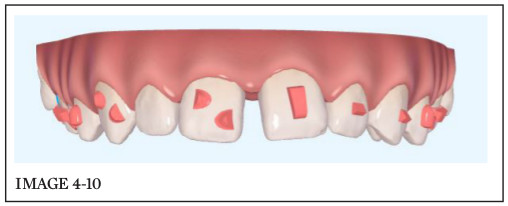Tipping is an “Invisalign free ride”. Since orthodontic forces are ap- plied to the crowns of teeth — a distance away from the center of rota- tion — teeth orthodontically tend to tip as they move, something we can capitalize upon with Invisalign treatment when tipping is desired. When we are planning movements that require tipping, major ClinCheck modifications are not needed, and these tipping movements are quite predictable.
In cases like this one pictured in image 4-1, where the patient presents with the UR1 and UL1 tipped away from each other, Invisalign treatment is very predictable, and the final ClinCheck stage is identical to the final clinical presentation (images 4-2, 4-3).



Tipping may also occur in cases of incisor retraction where the initial presentation is of flared and spaced upper and or lower incisors (images 4-4, 4-5). For the patient depicted in images 4-6, 4-7, the upper and low- er anterior teeth were retracted via tipping to both close the spaces as well as upright the teeth. Another Invisalign free ride!




CLINICAL CHALLENGE: BODILY MOVEMENT OF TEETH
The second way to close spaces is with bodily movement. Bodily movement is more challenging and the force systems acting upon the teeth are more complex. There are two ClinCheck modifications to con- sider when closing spaces via bodily movement:
- Attachments — attachments provide additional aligner “grip”. They may be optimized — placed automatically by the software and engi- neered to place the specific force systems necessary to achieve the desired tooth movement, or conventional. Note the attachments on the UR1 and UL1 in this patient (images 4-8, 4-9) who presented with a diastema. On the UR1, there is an optimized root-control attach- ment. On the UL1, there is a conventional vertical rectangular attach- ment. Both attachments provide additional push surfaces to assist in bodily movement.


- Virtual Gable Bends are adjustments we make in the ClinCheck plan as anti-tip. For example, in the aforementioned patient with a diastema between the UR1 and UL1, we need to move the teeth bodily to close the space — we do not want them to tip. If the teeth tip as they move, the crowns will tip off axis, the incisal edges will not be aligned, and there will be a dark triangle between the teeth at the gingival aspect. Clearly not what we want.
Instruction to the Technician: “Please add a 30-degree virtual Gable Bend URI UL1.”
The Virtual Gable Bend (VGB) places forces to the teeth to counteract the tendency to tip, similar to the use of a gable bend in an arch wire (image 4-10). Fifteen degrees of additional root tip is applied to each tooth, resulting in a total of 30 degrees. In images 4-11 through 4-14 we see the patient in progress and the teeth are still moving well, the diastema almost closed and the teeth still upright.

Stay updated, free dental videos. Join our Telegram channel

VIDEdental - Online dental courses


